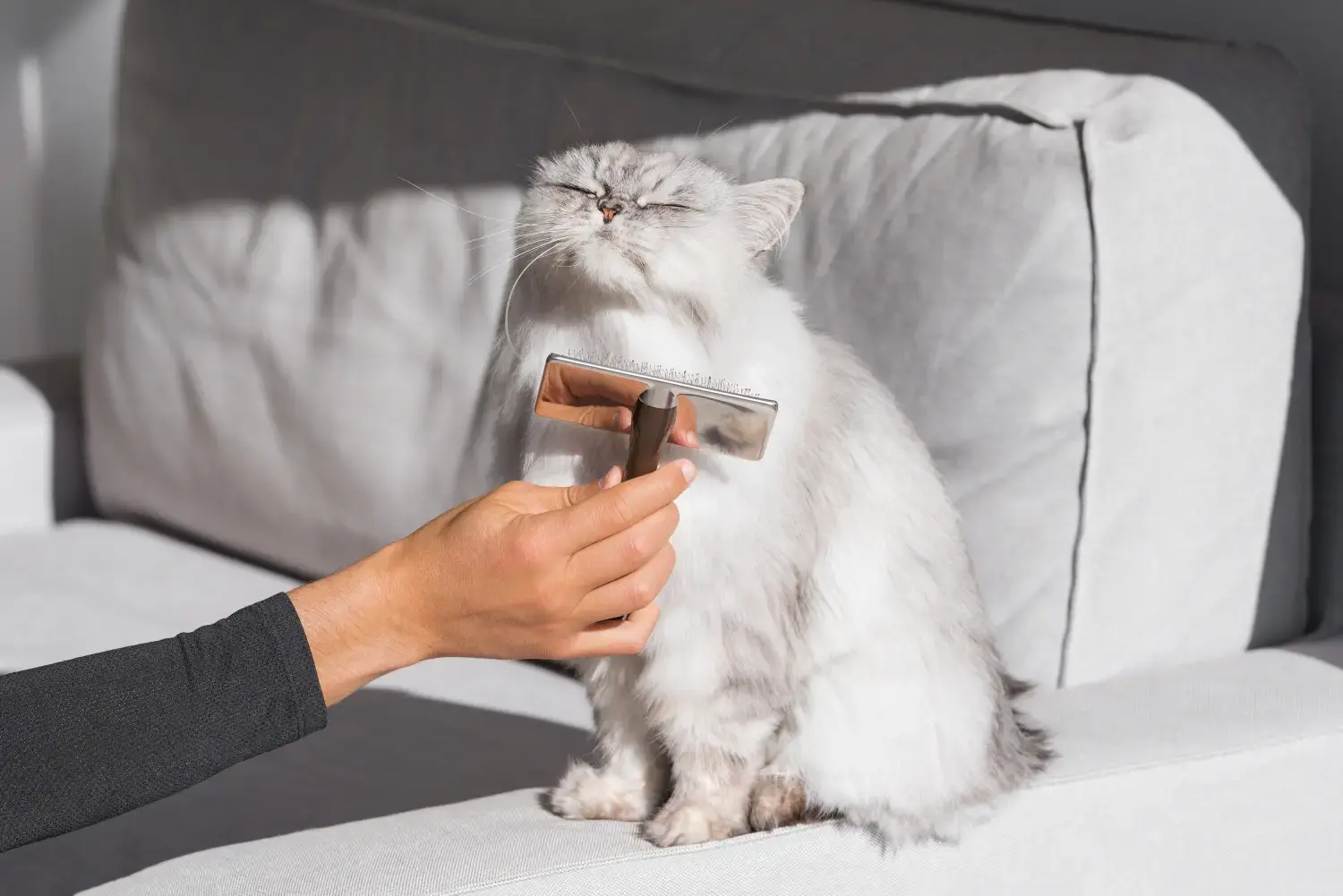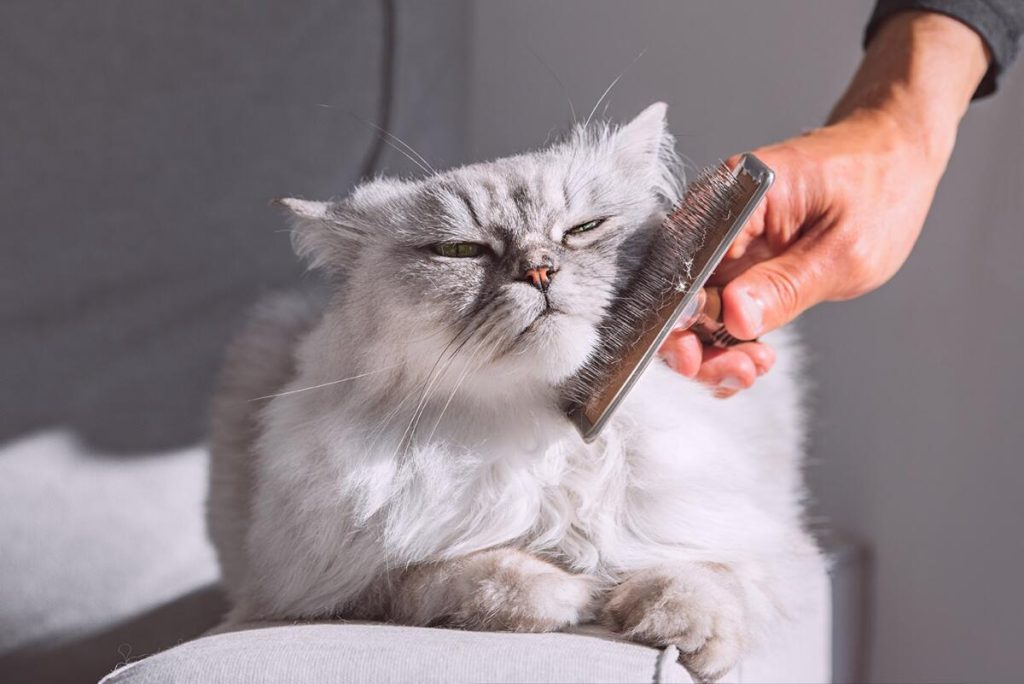Grooming your cat might seem like a simple task, but it’s more important than you think. When you take the time to groom your furry friend properly, you’re not just keeping them looking good—you’re improving their health and happiness too.
Imagine a cat with a shiny coat, fewer hairballs, and less itching. Sounds great, right? You’ll discover easy steps and expert tips to make grooming a stress-free, bonding experience for both you and your cat. Ready to learn how to keep your cat comfortable and clean?
Let’s get started!

Credit: www.youtube.com
Choosing The Right Grooming Tools
Grooming your cat helps keep its coat clean and healthy. Using the right tools makes grooming easier and safer.
Different cats have different coat types. Picking the correct tools for your cat’s coat type is important.
Brushes And Combs For Different Coats
Short-haired cats need soft bristle brushes to remove loose hair gently. Long-haired cats need brushes that reach deeper.
Combs help remove tangles and mats. Wide-tooth combs work well on thick coats. Fine-tooth combs help with sensitive skin.
- Soft bristle brush for short-haired cats
- Slicker brush for long-haired cats
- Wide-tooth comb for thick or curly fur
- Fine-tooth comb for delicate skin and small mats
Nail Clippers And Other Essentials
Trim your cat’s nails with special nail clippers made for pets. Avoid using human nail clippers to prevent injury.
Other tools include grooming gloves to remove loose hair and ear cleaners to keep ears healthy. Keep treats handy to reward your cat.
- Pet nail clippers with safety guard
- Grooming gloves for gentle hair removal
- Ear cleaning solution and cotton balls
- Towels for cleaning and drying
- Treats to reward good behavior

Credit: www.latimes.com
Preparing Your Cat For Grooming
Grooming your cat helps keep their fur clean and healthy. Preparing your cat before grooming makes the process easier and safer.
Start by making sure your cat feels safe and relaxed. This will help reduce stress during grooming.
Creating A Calm Environment
Choose a quiet room with soft lighting for grooming. Avoid loud noises and sudden movements that may scare your cat.
Keep grooming tools nearby and ready. This helps the process go smoothly without interruptions.
- Pick a quiet, comfortable space
- Use soft, natural light
- Remove distractions and loud sounds
- Have all grooming supplies ready
Getting Your Cat Comfortable With Touch
Spend time gently petting your cat daily. This helps them get used to being touched in different areas.
Touch your cat’s paws, ears, and tail carefully. Reward them with treats or soft praise to create a positive feeling.
- Pet your cat calmly every day
- Touch paws, ears, and tail gently
- Use treats to reward good behavior
- Stop if your cat shows signs of stress
Brushing Techniques For A Shiny Coat
Brushing your cat regularly helps keep their coat clean and healthy. It removes dirt, loose hair, and spreads natural oils.
Using the right brushing technique makes your cat comfortable. It also improves blood flow to the skin, giving a shiny look.
How Often To Brush
Brush short-haired cats once or twice a week. Long-haired cats need brushing every day or every other day.
Kittens and older cats may need gentler, more frequent brushing to keep their coat smooth.
Dealing With Mats And Tangles
Mats and tangles can hurt your cat’s skin and cause discomfort. Use a wide-toothed comb to gently work through small tangles.
For tough mats, try to loosen them slowly. If mats are large, visit a vet or groomer for help to avoid hurting your cat.
- Start brushing from the head and move toward the tail
- Hold the base of the fur near the skin to reduce pulling
- Use detangling sprays made for cats if needed
- Never cut mats with scissors yourself
Bathing Your Cat Safely
Bathing a cat can be tricky. Cats usually clean themselves well.
Sometimes, a bath is needed to keep your cat clean and healthy.
When And How To Bathe
Only bathe your cat if it is very dirty or has fleas. Avoid too many baths.
Use lukewarm water and keep the room warm to stop your cat from getting cold.
- Brush your cat before bathing to remove loose hair.
- Fill the tub or sink with a few inches of water.
- Gently place your cat in the water and stay calm.
- Use your hand to wet the fur slowly.
- Apply shampoo carefully, avoiding eyes and ears.
- Rinse well with clean, lukewarm water.
- Wrap your cat in a towel and dry gently.
Choosing Cat-friendly Shampoos
Use shampoos made for cats only. Human shampoos can hurt their skin.
Look for gentle, fragrance-free shampoos that clean without drying out fur.
- Check the label for “safe for cats.”
- Avoid shampoos with harsh chemicals or strong scents.
- Consider shampoos with natural ingredients like aloe or oatmeal.
- Ask your vet if your cat has skin problems.
Trimming Nails Without Stress
Trimming your cat’s nails can be easy and calm. Many cats dislike nail clipping. This guide helps you keep the process gentle and safe.
Using the right methods reduces stress for both you and your cat. Learn how to handle your cat and cut nails properly.
Proper Nail Cutting Techniques
Use sharp nail clippers made for cats. Hold your cat’s paw firmly but gently. Only trim the sharp tip of the nail. Avoid the pink part called the quick. Cutting the quick can cause pain and bleeding.
- Choose a quiet place with good light.
- Hold your cat’s paw and press gently to extend nails.
- Cut only the white tip of each nail.
- If you see pink, stop to avoid hurting your cat.
- Reward your cat with praise or treats after clipping.
Handling Resistant Cats
Some cats resist nail trimming. Stay calm and patient. Use gentle talking to soothe your cat. Try wrapping your cat in a towel to keep it still. If your cat struggles a lot, trim one or two nails at a time.
| Tip | How It Helps |
|---|---|
| Use a towel wrap | Keeps cat calm and prevents scratching |
| Trim nails after playtime | Cat is tired and less fidgety |
| Give treats during breaks | Rewards calm behavior and builds trust |
| Ask for help | Another person can hold the cat gently |
Cleaning Ears And Eyes
Keeping your cat’s ears and eyes clean is important for their health. Dirt and wax can build up and cause discomfort. Regular cleaning helps prevent infections and keeps your cat happy.
Use gentle methods to clean these sensitive areas. Always be careful not to hurt your cat or cause stress. Learn how to spot signs of problems early to get help fast.
Safe Cleaning Methods
Use a soft cloth or cotton ball dampened with warm water. Gently wipe the outer ear and the area around the eyes. Do not insert anything deep into the ear canal.
- Hold your cat calmly on your lap or a table.
- Use a damp cotton ball to clean the ear flap only.
- Wipe away dirt from the corner of the eyes carefully.
- Do not use alcohol or harsh chemicals.
- Dry the area with a clean soft cloth after cleaning.
Signs Of Infection To Watch For
Look for changes in your cat’s ears and eyes that may show infection. Early detection helps to get treatment quickly and avoid pain.
| Symptom | What It Means |
|---|---|
| Redness or swelling | Possible irritation or infection |
| Discharge or pus | Sign of bacterial or fungal infection |
| Bad odor | Ear infection likely |
| Frequent scratching or rubbing | Discomfort or itchiness |
| Squinting or excessive blinking | Eye irritation or pain |
Dealing With Shedding And Hairballs
Grooming cats helps control shedding and hairballs. These issues are common but manageable. Regular care keeps your cat comfortable and your home cleaner.
Shedding spreads loose fur around your home. Hairballs form when cats swallow hair while grooming. Both can cause problems if not addressed.
Reducing Shedding Through Grooming
Brushing your cat often removes loose fur. This reduces the amount of hair your cat sheds. Use the right tools for your cat’s coat type.
- Brush short-haired cats once a week
- Brush long-haired cats daily
- Use a slicker brush or grooming glove
- Be gentle to avoid hurting your cat
- Check for mats and tangles regularly
Preventing And Managing Hairballs
Hairballs form when cats swallow fur during grooming. You can help reduce hairballs with diet and grooming habits.
| Method | How It Helps |
| Regular brushing | Removes loose hair before swallowing |
| Hairball control food | Supports digestion and fur passage |
| Hydration | Keeps fur moving through the gut |
| Hairball remedies | Lubricate the digestive tract |

Credit: blog.homesalive.ca
When To Seek Professional Grooming Help
Grooming your cat is important for their health. Sometimes, you may need help from a professional groomer. Knowing when to ask for help keeps your cat safe and comfortable.
This guide will help you spot grooming problems and find the right groomer for your cat.
Recognizing Grooming Challenges
Some cats have fur that is hard to manage. Long hair can get tangled or matted. If mats are tight, they can hurt your cat’s skin.
Other signs you may need a groomer include:
- Cat shows pain when brushing
- Skin looks red or irritated
- Fur is very dirty or oily
- Cat is stressed during grooming
- Claws are too long or thick
Professional groomers know how to handle these problems safely. They have tools and skills to help your cat feel better.
Finding A Trusted Groomer
Look for a groomer who has experience with cats. Ask about their training and how they handle nervous pets. A good groomer works gently and watches your cat’s comfort.
Here are some tips to find a groomer you can trust:
- Read reviews from other cat owners
- Visit the salon before booking
- Ask about their grooming process
- Check if they handle emergencies
- Ensure they use pet-safe products
Choosing the right groomer helps your cat stay healthy and happy during grooming sessions.
Frequently Asked Questions
How Often Should I Groom My Cat?
Groom your cat at least once a week to prevent matting and reduce shedding. Long-haired cats need grooming more frequently, about 3-4 times weekly.
What Tools Are Best For Grooming Cats?
Use a soft-bristle brush for short hair and a slicker brush for long hair. A comb helps remove tangles and loose fur.
Can Grooming Improve My Cat’s Health?
Yes, grooming stimulates blood circulation, prevents skin issues, and reduces hairballs. It also helps you spot parasites or skin problems early.
How Do I Introduce Grooming To A Shy Cat?
Start slowly by gently brushing for a few minutes daily. Use treats and praise to create a positive grooming experience.
Conclusion
Grooming cats keeps them healthy and happy. Regular brushing reduces shedding. It also prevents matting. Trim their nails to avoid scratches. Clean ears gently to prevent infections. Bathing is rarely needed but can help with dirt. Use cat-friendly shampoos. Always be patient and gentle.
Your cat will appreciate the care. Building a routine makes grooming easier. Remember, each cat is unique. Some enjoy grooming, others need time. Observe your cat’s behavior. Adjust your approach as needed. With practice, grooming becomes a bonding time. Your efforts create a clean, healthy environment.
Enjoy the moments with your furry friend.
